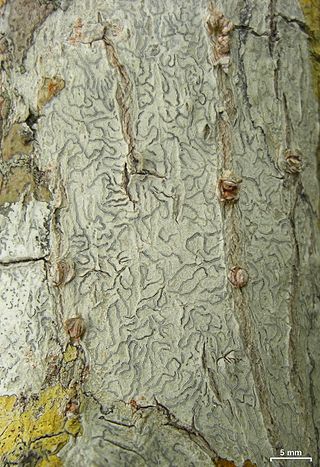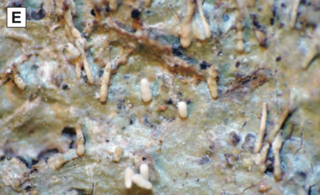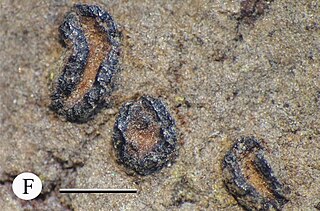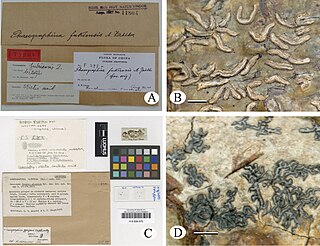
The Graphidaceae are a family of lichen-forming fungi in the order Graphidales. The family contains nearly a hundred genera and more than 2000 species. Although the family has a cosmopolitan distribution, most Graphidaceae species occur in tropical regions, and typically grow on bark.

Sarcographa is a genus of lichen-forming fungi in the family Graphidaceae. It is estimated to contain 37 species. The genus was circumscribed by French botanist Antoine Laurent Apollinaire Fée in 1825.

Platythecium is a genus of lichen-forming fungi in the family Graphidaceae. It contains an estimated 27 species.

Platygramme is a genus of lichen-forming fungi in the family Graphidaceae consisting of about 30 species. The genus was circumscribed by Antoine Laurent Apollinaire Fée in 1874.

Graphis is a genus of lichen-forming fungi in the family Graphidaceae.

Fissurina is a genus of lichenized fungi in the family Graphidaceae. It has about 160 species, most of which are found in tropical regions.

Diorygma is a genus of lichen-forming fungi in the family Graphidaceae. The genus was circumscribed by Franz Gerhard Eschweiler in 1824. Species of the genus are widely distributed in tropical and subtropical regions of the world.

Acanthothecis is a genus of lichen-forming fungi in the family Graphidaceae. The genus was circumscribed by Frederick Edward Clements in 1909.

Acanthotrema is a genus of lichens in the family Graphidaceae. The genus was circumscribed by German lichenologist Andreas Frisch in 2006, with Acanthotrema brasilianum assigned as the type species. Acanthotrema species are commonly found in rainforests ranging from lowland to montane environments.
André Aptroot is a Dutch mycologist and lichenologist. His primary research focus is on biodiversity, particularly tropical lichens, encompassing systematics, floristic surveys, and taxonomic reviews. A prolific researcher, he has published more than 500 scientific papers and described hundreds of new fungal and lichen species.

Allographa is a genus of script lichens in the family Graphidaceae. It has nearly 200 species. Formally circumscribed in 1824 by François Fulgis Chevallier, Allographa was formerly included in Graphis, but was upgraded to generic status in 2018 by lichenologists Klaus Kalb and Robert Lücking.
Allographa aptrootiana is a species of script lichen in the family Graphidaceae that is found in tropical Africa. It was formally described as a new species in 2014 by Dries Van den Broeck, Robert Lücking, and Damien Ertz. The type locality is Yaengo (Orientale Province, Democratic Republic of the Congo; here it was found growing on the bark of an unidentified tree species in an evergreen forest. The lichen somewhat resembles Graphis tetralocularis in overall morphology, but unlike that species it has a completely carbonized excipulum, and does not produce the secondary compound atranorin. The holotype specimen is parasitised with Etayoa trypethelii, a widespread tropical lichenicolous fungus. The specific epithet aptrootiana honours André Aptroot, "in recognition of his many contributions to tropical lichenology". The taxon was transferred to Allographa in 2018 following a reinstatement and reorganization of that genus.
Henricus (Harrie) Johannes Maria Sipman is a retired Dutch lichenologist who specialised in tropical and subtropical lichens and authored or co-authored over 250 scientific publications. He was the curator of the lichen herbarium at the Berlin Botanical Garden and Botanical Museum from 1983 until his retirement in 2010.
Pseudochapsa is a genus of lichen-forming fungi in the family Graphidaceae. It has 19 species. It was circumscribed in 2012 by Sittiporn Parnmen, Robert Lücking, and Helge Thorsten Lumbsch, with Pseudochapsa dilatata as the type species. Pseudochapsa differs from Chapsa it that its excipulum is typically brown. Additionally, its ascospores are mostly discoseptate and amyloid. The generic name combines the Greek pseudo ("false") with the genus name Chapsa.
Cruentotrema is a genus of corticolous (bark-dwelling) lichens in the family Graphidaceae. It has seven species.

Graphidales is an order of lichen-forming fungi in the class Lecanoromycetes. It contains 6 families, about 81 genera and about 2,228 species. Family Graphidaceae are the largest crustose family within Graphidales order comprising more than 2000 species, which are widely distributed in tropical and subtropical regions of the world.
Gintarasia is a genus of lichen-forming fungi in the family Graphidaceae. It has seven species, all of which are found in Australia. Gintarasia species are corticolous (bark-dwelling), crustose lichens with a thelotremoid form.
Pallidogramme is a genus of lichen-forming fungi in the family Graphidaceae. It has 8 species of corticolous (bark-dwelling), crustose lichens.
Malmographina is a fungal genus in the family Graphidaceae. The genus is monotypic, containing the single species Malmographina plicosa, a script lichen found in South America. Genus Malmographina is characterised by its smooth, olive-green thallus, erumpent to prominent lirellae with orange to cinnabar-red pigment, a clear hymenium, and hyaline, non-amyloid ascospores.










